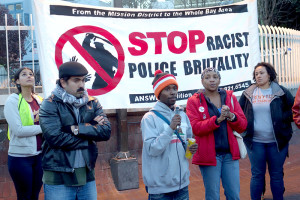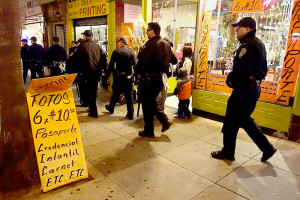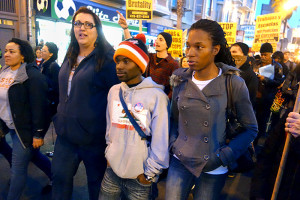Protesters March With Victim Against Alleged Police Brutality

San Francisco residents marched through the Mission District last Thursday evening, protesting last month’s incident of alleged police brutality against college student Kevin Clark.
Clark, an 18-year-old student at the City College of San Francisco, was detained near the 24th and Mission BART station after allegedly assaulting another individual in front of two police officers. The incident was caught on cell phone video and uploaded to YouTube, sparking outrage in the community.
“I just want to say, thank you everybody coming out. I didn’t think this would have this big an effect on the community, but it looks like it’s made a huge impact,” Clark told the crowd close to the location where the incident took place. “So thank you and hopefully we can stop this and make the streets safer and people won’t have to worry about the police harassing them.”
Supporters of Clark allege that he was “peacefully walking down the street” when the SFPD apprehended him. They claim that the officers used excessive force by pushing his face into a storm drain to prevent him from resisting arrest.
Clark has not commented on the allegations of assault. He has been cited for two counts of resisting arrest, the police have reported.

after protests.
The march was organized by Act Now to Stop War and End Racism, and was co-sponsored by multiple socialist organizations and supporters of previous victims of alleged police brutality, including the Justice 4 Alan Blueford Coalition, the Kenneth Harding Foundation and relatives of Oscar Grant, who was killed by BART police on New Year’s Day in 2009.
Speakers expressed a sense of desperation in light of what they saw as increased police violence in the Mission District and the gentrification of their community. Flyde Benzo, an organizer from Bayview and an alleged victim of police brutality, argued that, “blacks are being pushed out of San Francisco.”
“In San Francisco, African Americans who comprise less than 5 percent of the population are seven times as likely to be arrested as any other race,” said Benzo. The African-American community in San Francisco also has the highest rate of unemployment, at 10.4 percent, according to a study by the city of San Francisco.
In the 2009 study, former Mayor Gavin Newsom acknowledged the issue, terming it the “Out-Migration of the African-American population.”
As the protesters made their way across Mission Street to the police headquarters on 17th and Valencia, police officers escorted the crowd on all sides, protecting local businesses and keeping the protesters out of oncoming traffic.
Some business owners claimed they did not have any issues with the protests, while others told a different story.

police brutality.
Alexia Staniotes and Rhiannon Charisse, employees of The Dark Room Theatre on Mission Street, thanked the officers as they walked by.
They’ve never had any issues with the people who are there to march peacefully, Charisse explained, but some people who linger after the march often cause damage to local businesses.
“We get tags a lot, we get a lot of tags up here,” said Staniotes, pointing toward the upper wall of the theatre where the sign hangs. “I think one time, during a protest our sign got busted, and we had to pay for that.”
Vincent R., a hip-hop artist from the Park Merced neighborhood said he was marching with the protesters because he’s frustrated with the American legal system and police.
“I got convicted of a crime I didn’t commit when I was 16 so I know how unfair the justice system is,” he explained. “The bad ones need to go; they get paid vacations when they’re under trial, that doesn’t make sense to me. We’re paying for that paid vacation.”
Protesters were given the chance to speak at the microphone in front of the police station. Many spoke angrily, calling for the officers to come out into the streets to join them and blaming different groups for the problems of the community. They focused mostly on the themes of crime and education.
Marcela San Miguel, who teaches at the City College of San Francisco, said she taught Clark last semester in her Composition and Literature class. She stated that he was one of two people to get an A in her class.
“He came every day to class, he was on time, he was prepared, he did his homework, he participated. He was very respectful,” she said, speaking in front of the police station.
She showed the video to her class of students, 12 of who were present at the event. “I want to encourage them and inspire them but after they saw that, how do I give them that hope, that there is a way out?” she emotionally asked.
Adam Jordan, 43, grew up in San Francisco and spoke angrily about what he says he witnessed and experienced during his childhood.
“Before cell phones and the videos was out, when we was on the way to school, if you was truant, they’d grab you by the back of the neck, slam you against the car and rifle through your pockets like you was a drug dealer, when all you was trying to do is go to school,” Jordan angrily exclaimed.
Jordan echoed many of the sentiments heard throughout the day on the role of education in changing circumstances.
“Cause these streets is hard. And through education you can realize the potential of your entire life. That’s what we need,” Jordan proclaimed.
The protest ended abruptly at around 7 p.m. when heavy rain began to fall, forming rivers in the streets; it had been expected to go on later into the night.
Officer Albie Esparza of the SFPD’s Media Relations Unit said the force appears reasonable, and called the situation involving the storm drain “unfortunate.”
“The person he was going to assault or was in the process of assaulting was just released from police custody with a citation for jaywalking,” said Esparza. “So, that person was in front of the officers walking away, and the suspect approached that person and began engaging in a confrontation.”
Esparza could not confirm if Clark physically assaulted the individual, or if he was in the process of doing so when the two officers approached him.














